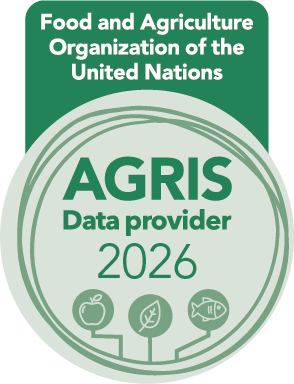Assessment of physiological and quality traits of peace lily(Spathiphyllum wallisii) under coloured shade nets
DOI:
https://doi.org/10.24154/jhs.v20i1.4034Keywords:
Coloured shade nets, physiology, quality, SpathiphyllumAbstract
Studies were carried out to evaluate the physiological and quality traits of peace lily (Spathiphyllum wallisii) under different shade nets (50% shading) and control (tree shade). The results showed that plants grown under black-coloured shade nets recorded the maximum total chlorophyll content in leaves (79.02 SPAD units) and photosynthetic rate (1.64 μmol CO₂ m⁻² s⁻¹), while white shade nets promoted early flowering. The number of flowers produced per plant (2.00), flower stalk length (43.23 cm), flower stalk diameter (3.58 mm), spathe length (15.10 cm), spathe width (6.09 cm), and vase life (2.44 days) were highest in plants grown under black-coloured shade nets. Peace lily grown under black shade nets also showed overall better performance in root and foliage quality parameters; therefore, black shade nets can be recommended for commercial cultivation of peace lily.
Downloads
References
Chen, J., McConnell, D. B., Henny, R. J., & Everitt, K. C. (2003). Cultural guidelines for commercial production of interiorscape Spathiphyllum: ENH958/EP161, 7/2003. EDIS, 2003(18). https://doi.org/10.32473/edis-ep161-2003
Da Silva, M. W., Ono, E. O., Santos, M. H. L. C., Beckmann-Cavalcante, M. Z., Oliveira, G. M., Ferreira, D. N. C., & Lopes, C. C. (2017). Growth and production of Heliconia under different light conditions. Semina: Ciências Agrárias, 38(1), 7–17. https://doi.org/10.5433/1679-0359.2017v38n1p7
Gaurav, A. K., Raju, D. V. S., Janakiram, T., Singh, B., Jain, R., & Krishnan, S. G. (2016). Effect of different coloured shade nets on production and quality of cordyline. Indian Journal of Agricultural Sciences, 86(7), 865–869. https://doi.org/10.56093/ijas.v86i7.59736
Ilić, Z. S., Milenković, L., Šunić, L., & Fallik, E. (2015). Effect of coloured shade nets on plant leaf parameters and tomato fruit quality. Journal of the Science of Food and Agriculture, 95(13), 2660–2667. https://doi.org/10.1002/jsfa.7000
Li, T., Bi, G., LeCompte, J., Barickman, T. C., & Evans, B. B. (2017). Effect of colored shadecloth on the quality and yield of lettuce and snapdragon. HortTechnology, 27(6), 860–867. https://doi.org/10.21273/HORTTECH03809-17
Lima, J. D., Nomura, E. S., Fuzitani, E. J., & Silva, S. D. (2010). Physiological variables in anthurium cultivated under different shading screen. Revista Scientia Agraria, 11(3), 233–239. https://doi.org/10.5380/rsa.v11i3.17232
Myrthong, A. L., & Sudhadevi, P. K. (2016). Performance evaluation of Nephrolepis exaltata and Asparagus densiflorus under different coloured shade nets. International Journal of Applied and Pure Sciences and Agriculture, 2(7), 113–117.
Naveena, N., Thamaraiselvi, S. P., Rajadurai, K. R., & Sivakumar, R. (2019). Effect of coloured shade nets on physiology and quality of cut foliage plants. Journal of Pharmacognosy and Phytochemistry, 8(4), 1141–1144.
Nomura, E. S., Lima, J. D., Rodrigues, D. S., Garcia, V. A., Fuzitani, E. J., & Silva, S. H. M. G. D. (2009). Growth and yield of anthurium under different shading screens. Ciência Rural, 39(5), 1394–1400. https://doi.org/10.1590/S0103-84782009000500014
Stamps, R. H., & Chandler, A. L. (2006). Differential effects of colored shade nets on three cut foliage crops. In XXVII International Horticultural Congress-IHC2006: International Symposium on Cultivation and Utilization of Asian Plants (Vol. 770, pp. 169–176). International Society for Horticultural Science. https://doi.org/10.17660/ActaHortic.2008.770.19
Zhao, D., Hao, Z., & Tao, J. (2012). Effects of shade on plant growth and flower quality in the herbaceous peony (Paeonia lactiflora Pall.). Plant Physiology and Biochemistry, 61, 187–196. https://doi.org/10.1016/j.plaphy.2012.10.005
Downloads
Published
Data Availability Statement
NA
Issue
Section
License
Copyright (c) 2025 N R Poojashree, T Suseela, A V D Dorajee Rao, P Subbaramamma, R V Sujatha (Author)

This work is licensed under a Creative Commons Attribution-NonCommercial-ShareAlike 4.0 International License.
Authors retain copyright. Articles published are made available as open access articles, distributed under the terms of the Creative Commons Attribution-NonCommercial-ShareAlike 4.0 International License, which permits unrestricted non-commercial use, distribution, and reproduction in any medium, provided the original author and source are credited. 
This journal permits and encourages authors to share their submitted versions (preprints), accepted versions (postprints) and/or published versions (publisher versions) freely under the CC BY-NC-SA 4.0 license while providing bibliographic details that credit, if applicable.







 .
. 











